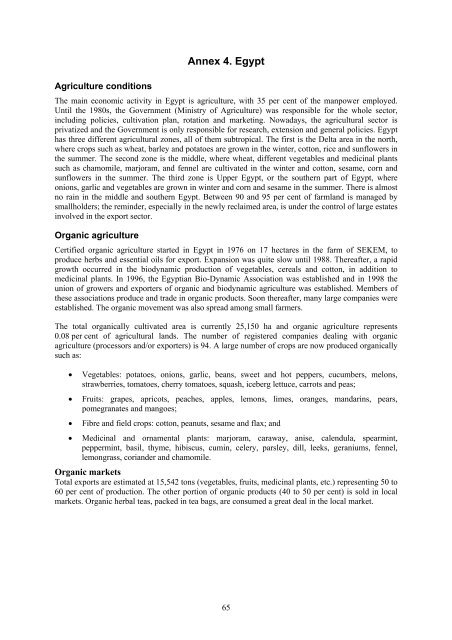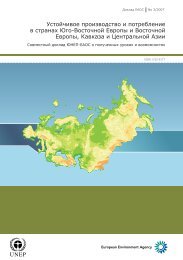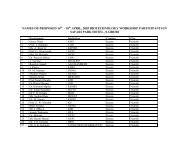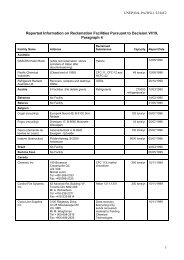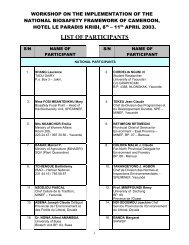Best Practices for Organic Policy - What developing country - UNEP
Best Practices for Organic Policy - What developing country - UNEP
Best Practices for Organic Policy - What developing country - UNEP
You also want an ePaper? Increase the reach of your titles
YUMPU automatically turns print PDFs into web optimized ePapers that Google loves.
Agriculture conditions<br />
Annex 4. Egypt<br />
The main economic activity in Egypt is agriculture, with 35 per cent of the manpower employed.<br />
Until the 1980s, the Government (Ministry of Agriculture) was responsible <strong>for</strong> the whole sector,<br />
including policies, cultivation plan, rotation and marketing. Nowadays, the agricultural sector is<br />
privatized and the Government is only responsible <strong>for</strong> research, extension and general policies. Egypt<br />
has three different agricultural zones, all of them subtropical. The first is the Delta area in the north,<br />
where crops such as wheat, barley and potatoes are grown in the winter, cotton, rice and sunflowers in<br />
the summer. The second zone is the middle, where wheat, different vegetables and medicinal plants<br />
such as chamomile, marjoram, and fennel are cultivated in the winter and cotton, sesame, corn and<br />
sunflowers in the summer. The third zone is Upper Egypt, or the southern part of Egypt, where<br />
onions, garlic and vegetables are grown in winter and corn and sesame in the summer. There is almost<br />
no rain in the middle and southern Egypt. Between 90 and 95 per cent of farmland is managed by<br />
smallholders; the reminder, especially in the newly reclaimed area, is under the control of large estates<br />
involved in the export sector.<br />
<strong>Organic</strong> agriculture<br />
Certified organic agriculture started in Egypt in 1976 on 17 hectares in the farm of SEKEM, to<br />
produce herbs and essential oils <strong>for</strong> export. Expansion was quite slow until 1988. Thereafter, a rapid<br />
growth occurred in the biodynamic production of vegetables, cereals and cotton, in addition to<br />
medicinal plants. In 1996, the Egyptian Bio-Dynamic Association was established and in 1998 the<br />
union of growers and exporters of organic and biodynamic agriculture was established. Members of<br />
these associations produce and trade in organic products. Soon thereafter, many large companies were<br />
established. The organic movement was also spread among small farmers.<br />
The total organically cultivated area is currently 25,150 ha and organic agriculture represents<br />
0.08 per cent of agricultural lands. The number of registered companies dealing with organic<br />
agriculture (processors and/or exporters) is 94. A large number of crops are now produced organically<br />
such as:<br />
• Vegetables: potatoes, onions, garlic, beans, sweet and hot peppers, cucumbers, melons,<br />
strawberries, tomatoes, cherry tomatoes, squash, iceberg lettuce, carrots and peas;<br />
• Fruits: grapes, apricots, peaches, apples, lemons, limes, oranges, mandarins, pears,<br />
pomegranates and mangoes;<br />
• Fibre and field crops: cotton, peanuts, sesame and flax; and<br />
• Medicinal and ornamental plants: marjoram, caraway, anise, calendula, spearmint,<br />
peppermint, basil, thyme, hibiscus, cumin, celery, parsley, dill, leeks, geraniums, fennel,<br />
lemongrass, coriander and chamomile.<br />
<strong>Organic</strong> markets<br />
Total exports are estimated at 15,542 tons (vegetables, fruits, medicinal plants, etc.) representing 50 to<br />
60 per cent of production. The other portion of organic products (40 to 50 per cent) is sold in local<br />
markets. <strong>Organic</strong> herbal teas, packed in tea bags, are consumed a great deal in the local market.<br />
65


